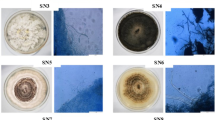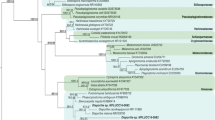Abstract
Trans-resveratrol is an enormously exploited stilbene exhibiting a broad spectrum of biological activities. However, commercial production to meet the demand and supply is very difficult as it is largely extracted from plants such as Polygonum cuspidatum making it very expensive. In the present study, resveratrol-producing endophytic fungi have been investigated for their in vitro antioxidant, antifungal and anti-staphylococcal activities. All the four fungal endophytes exhibited significant resveratrol production in the range of 31.3–89.1 mg/L in liquid cultures which was evaluated by high-performance liquid chromatography analysis. The endophytic isolate #12VVLPM in the present study exhibited strong antioxidant property in case of 2,2-diphenyl-1-picrylhydrazyl, Trolox equivalent antioxidant capacity, metal ion chelating, Nitric oxide radical and Hydrogen peroxide with IC50 values of 0.11–4.96, 0.28–2.16, 0.12–1.33, 0.08–1.35 and 0.12–1.18 mg/mL, respectively. The maximum inhibition (57.76 ± 0.82%) was exhibited by #12VVLPM against Botrytis cinerea. The present result shows strong correlation between antioxidant activities, anti-staphylococcal as well as antifungal activity.
Graphical Abstract




Similar content being viewed by others
Abbreviations
- DPPH:
-
2,2-Diphenyl-1-picrylhydrazyl
- TEAC:
-
Trolox equivalent antioxidant capacity
- FRAP:
-
Ferric reducing antioxidant power
- TPC:
-
Total phenolic content
- TFC:
-
Total flavonoids content
- RESV:
-
Resveratrol
- MHA:
-
Mueller Hinton agar
- SDA:
-
Sabouraud dextrose agar
- MTCC:
-
Microbial type culture collection
- ATCC:
-
American type culture collection
- Sau:
-
Staphylococcus aureus
References
Strobel G, Daisy B (2003) Bioprospecting for microbial endophytes and their natural products. Microbiol Mol Biol Rev 67(4):491–502
Suryanarayanan TS, Thirunavukkarasu N, Govindarajulu MB, Sasse F, Jansen R, Murali TS (2009) Fungal endophytes and bioprospecting. Fungal Biol Rev 23(1–2):9–19
Parker JA, Arango M, Abderrahmane S, Lambert E, Tourette C, Catoire H, Néri C (2005) Resveratrol rescues mutant polyglutamine cytotoxicity in nematode and mammalian neurons. Nat Genet 37(4):349
Petrovski G, Gurusamy N, Das DK (2011) Resveratrol in cardiovascular health and disease. Ann N Y Acad Sci 1215(1):22–33
Wang DG, Liu WY, Chen GT (2013) A simple method for the isolation and purification of resveratrol from Polygonum cuspidatum. J Pharmaceut Anal 3(4):241–247
Ramana KV, Reddy A, Majeti NV, Singhal SS (2018) Therapeutic potential of natural antioxidants. Oxidative Med Cell Longev. https://doi.org/10.1155/2018/9471051
Ratz-Łyko A, Arct J (2018) Resveratrol as an active ingredient for cosmetic and dermatological applications: a review. J Cosmet Laser Therapy. https://doi.org/10.1080/14764172.2018.1469767
Simioni C, Zauli G, Martelli AM, Vitale M, Sacchetti G, Gonelli A, Neri LM (2018) Oxidative stress: the role of physical exercise and antioxidant nutraceuticals in adulthood and aging. Oncotarget 9(24):171–181
Berman AY, Motechin RA, Wiesenfeld MY, Holz MK (2017) The therapeutic potential of resveratrol: a review of clinical trials. NPJ Precis Oncol 1(1):35
Mehton RK, Meshram V, Saxena S, Chhibber M (2016) Synthesis and anti-staphylococcal activity of 2, 4-disubstituted diphenylamines. J Braz Chem Soc 27(7):1236–1244
Saxena S, Gomber C (2010) Surmounting antimicrobial resistance in the millennium superbug: Staphylococcus aureus. Open Med (previously Central European Journal of Medicine) 5(1):12–29
Ma DS, Tan LTH, Chan KG, Yap WH, Pusparajah P, Chuah LH, Goh BH (2018) Resveratrol—potential antibacterial agent against foodborne pathogens. Front Pharmacol 9:102
Paulo L, Ferreira S, Gallardo E, Queiroz JA, Domingues F (2010) Antimicrobial activity and effects of resveratrol on human pathogenic bacteria. World J Microbiol Biotechnol 26(8):1533–1538
Mora-Pale M, Bhan N, Masuko S, James P, Wood J, McCallum S, Koffas MA (2015) Antimicrobial mechanism of resveratrol-trans-dihydro dimer produced from the peroxidase-catalyzed oxidation of resveratrol. Biotechnol Bioeng 112(12):2417–2428
Deshmukh S, Gupta M, Prakash V, Saxena S (2018) Endophytic fungi: a source of potential antifungal compounds. J Fungi 4(3):77
Dwibedi V, Saxena S (2018) Arcopilus aureus, a resveratrol-producing endophyte from Vitis vinifera. App Biochem Biotechnol 186(2):476–495
Ho R, Violette A, Cressend D, Raharivelomanana P, Carrupt PA, Hostettmann K (2012) Antioxidant potential and radical-scavenging effects of flavonoids from the leaves of Psidium cattleianum grown in French Polynesia. Nat Prod Res 26(3):274–277
Re R, Pellegrini N, Proteggente A, Pannala A, Yang M, Rice-Evans C (1999) Antioxidant activity is applying an improved ABTS radical cation decolorization assay. Free Radic Biol Med 26(9–10):1231–1237
Danagoudar Josh CG, Sunil Kumar R, Poyya J, Nivya T, Hulikere MM, AnuAppaiah KA (2017) Molecular profiling and antioxidant as well as the anti-bacterial potential of polyphenol producing endophytic fungus-Aspergillus austroafricanus CGJ-B3. Mycology 8(1):28–38
Patel A, Patel A, Patel A, Patel NM (2010) Determination of polyphenols and free radical scavenging activity of Tephrosiapurpurea Linn. leaves (Leguminosae). Pharmacogn Res 2(3):152
Ruch RJ, Cheng SJ, Klaunig JE (1989) Prevention of cytotoxicity and inhibition of intercellular communication by antioxidant catechins isolated from Chinese green tea. Carcinogenesis 10(6):1003–1008
Ghildiyal A, Pandey A (2008) Isolation of cold tolerant antifungal strains of Trichoderma sp. from glacial sites of Indian Himalayan region. Res J Microbiol 3(8):559–564
Meshram V, Saxena S, Kapoor N (2012) In vitro anti-staphylococcal potential of endophytic fungi from Aegle marmelos. J Pure App Microbiol 6(4):1859–1868
Wang J, Cox DG, Ding W, Huang G, Lin Y, Li C (2014) Three new resveratrol derivatives from the mangrove endophytic fungus Alternaria sp. Mar Drugs 12(5):2840–2850
Khanduja KL, Bhardwaj A (2003) Stable free radical scavenging and anti-peroxidative properties of resveratrol compared in vitro with some other bioflavonoids. Indian J Biochem Biophys 40(6):416–422
Shrikanta A, Kumar A, Govindaswamy V (2015) Resveratrol content and antioxidant properties of underutilized fruits. J Food Sci Technol 52(1):383–390
Zhou J, Diao X, Wang T, Chen G, Lin Q, Yang X, Xu J (2018) Phylogenetic diversity and antioxidant activities of culturable fungal endophytes associated with the mangrove species Rhizophorastylosa and R. mucronata in the South China Sea. PloS ONE 13(6):e0197359
Gülçin İ (2010) Antioxidant properties of resveratrol: a structure-activity insight. Innov Food Sci Emerg Technol 11(1):210–218
Houille B, Papon N, Boudesocque L, Bourdeaud E, Besseau S, Courdavault V, Clastre M (2014) Antifungal activity of resveratrol derivatives against Candida species. J Nat Prod 77(7):1658–1662
Balik J, Kyselakova M, Vrchotová N, Tříska J, Kumšta M, Veverka J, Lefnerová D (2008) Relations between polyphenols content and antioxidant activity in vine grapes and leaves. Czech J Food Sci 26:S25–S32
Fernández-Pachón MS, Villano D, Troncoso AM, García-Parrilla MC (2006) Determination of the phenolic composition of sherry and table white wines by liquid chromatography and their relation with antioxidant activity. Anal Chim Acta 563(1–2):101–108
Acknowledgements
The authors thank to the Department of Biotechnology (DBT), Government of India, New Delhi, for financial assistance through Project No-BT/PR9094/NDB/39/378/2013 and to Thapar Institute of Engineering and Technology, Patiala, Punjab, for providing the necessary infrastructure to carry out the research work. They also acknowledge Mr. Saurabh Rawat Assistant Manager, Sula Vineyards Pvt. Ltd. Nashik India for providing samples.
Author information
Authors and Affiliations
Contributions
Prof. SS conceived and designed the present study, while VD performed all experiments, analysed the data. Prof. SS and VD jointly wrote the publication.
Corresponding author
Ethics declarations
Conflict of interest
The authors declare no conflict of interest to publish this manuscript.
Additional information
Publisher's Note
Springer Nature remains neutral with regard to jurisdictional claims in published maps and institutional affiliations.
Significance Statement Resveratrol is extensively being used as a therapeutic moiety, as well as a pharmacophore for development of new drugs due to its multifarious beneficial effects. In the present study, resveratrol-producing endophytic fungi have been investigated for their in vitro antioxidant, antifungal and anti-staphylococcal activities.
Rights and permissions
About this article
Cite this article
Dwibedi, V., Saxena, S. In Vitro Anti-oxidant, Anti-fungal and Anti-staphylococcal Activity of Resveratrol-Producing Endophytic Fungi. Proc. Natl. Acad. Sci., India, Sect. B Biol. Sci. 90, 207–219 (2020). https://doi.org/10.1007/s40011-019-01098-6
Received:
Revised:
Accepted:
Published:
Issue Date:
DOI: https://doi.org/10.1007/s40011-019-01098-6




